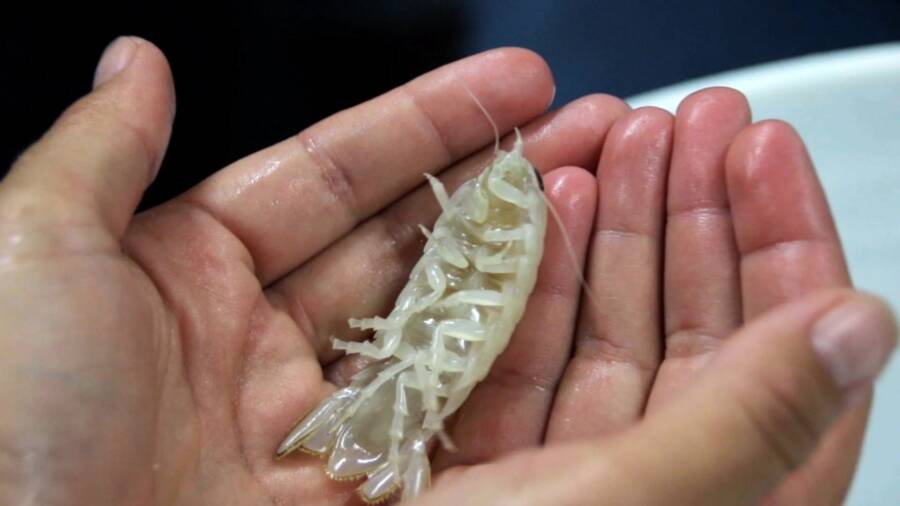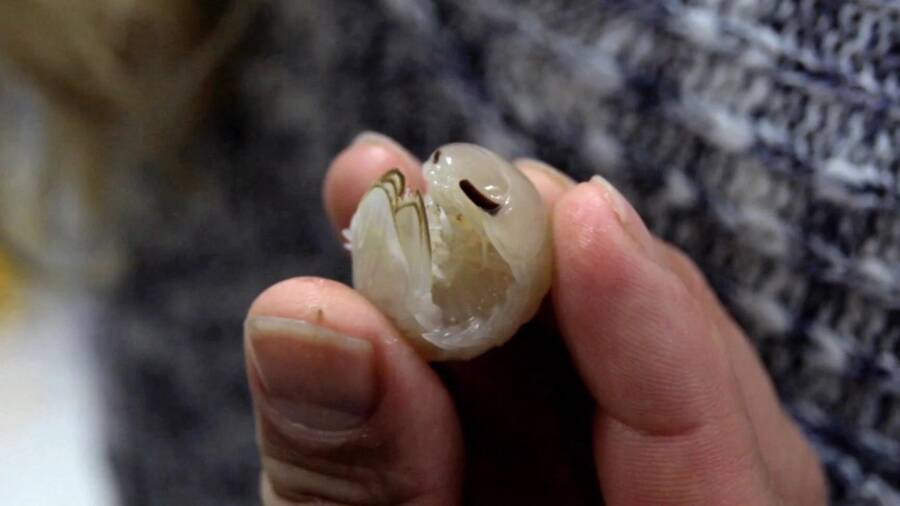Booralana nickorum was discovered 1,800 feet beneath the surface of the Exuma Sound off the coast of the Bahamas.

Shipley, et a. / ZootaxaBooralana nickorum, the translucent crustacean species discovered in the Bahamas.
A team of international marine biologists recently discovered an ancient crustacean with a translucent body and giant eyes in the Bahamas.
In a paper published in the journal Zootaxa, researchers identified the species as Booralana nickorum, a deep-sea isopod that has existed on Earth for 300 million years and may play an important role in maintaining the ecosystem.
Isopods are largely scavengers, living in the deepest parts of the ocean and recycling energy to keep the ecosystem healthy. However, there is also evidence to suggest that certain isopods may attack living vertebrates, such as sharks, for food. Booralana nickorum, like many of these other isopods, can also survive for several years without any food.
It was discovered more than 500 meters (1,640 feet) beneath the surface of the Exuma Sound in the Bahamas, where the water is cold and dark. Since it lives at such great depths, the crustacean requires no pigmentation, so its hard exoskeleton is white and slightly translucent. Its large eyes are used to find food in the depths of the sea.

OceanXB. nickorum grows to between two and three inches long, making it much larger than its land-based cousin, the pill bug.
“This work highlights the cryptic diversity of this group and underscores how little we know about deep-sea ecosystems in The Bahamas,” said study co-author Oliver Shipley in a statement. As with this new discovery, Shipley said he believes there is “a potentially hidden ‘treasure chest’ of unrecognized biodiversity in these waters.”
The species was discovered during a series of dives dating back to 2014 in a collaboration between Cape Eleuthera Institute and OceanX. Though researchers didn’t perform a genetic analysis, the team was able to identify B. nickorum as a new species through close observation of its physical characteristics — namely, its tail, which it uses to push itself along in the water.
A 3D model created by the researchers illustrates how this tail functions.
Duncan Irschick / University of Massachusetts AmherstA 3D model illustrating B. nickorum.
B. nickorum is significantly smaller than the world’s largest isopod, Bathynomus giganteus, which can grow to be more than a foot in length and was also found in the Exuma Sound.
Up until now, researchers believed that only one other species of Booralana existed in the Caribbean, Booralana tricarinata.
Mostly, B. nickorum feeds on the various debris and organic matter that naturally sifts its way to the ocean floor in the Exuma Sound.
“Seagrass, mangroves, all that sort of stuff gets swept off the shelves and basically dumped right down into this deep-sea community,” Shipley said in an interview with Gizmodo. “And that’s really important, because the more energy there is, the better the chances are that there are higher levels of biodiversity down there as well.”
Recent discoveries in these deep-sea environments have confirmed what many researchers have long believed to be true — that we are nowhere near close to fully understanding the mysteries of Earth’s oceans. After all, B. nickorum has been lurking below the surface for longer than humans have been on the planet, and researchers are just now learning about it.

OceanXB. nickorum and other isopods emerged around 300 million years ago.
“Caribbean deep sea ecosystems are really, really, really poorly studied,” Shipley said. “The potential for novel discovery is massive.”
However, like many of Earth’s ecosystems, the deep ocean is under constant threat from pollution and climate change. Without taking proper steps to ensure these ecosystems are protected, many species could continue to go undetected — or become extinct before scientists ever learn of their existence.
“The Caribbean houses many deep-sea ecosystems that could be considered pristine, mostly hidden from anthropogenic exploitation, such as deep-sea fisheries and mining,” Shipley added. “Therefore, they provide a baseline from which to compare exploitation effects occurring in less pristine regions. However, these systems are not immune from the increasing impacts of climate changes and pollution, so it is critical that we understand the full extent of the biodiversity supported by these deep-sea environments.”
After learning about the discovery of this deep-sea crustacean, meet the giant isopod, the 20-inch-long crustacean of your nightmares. Then, learn about the supergiant “sea cockroach” scientists called Darth Vader.





